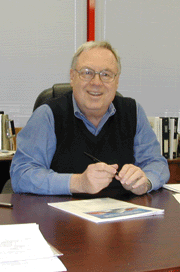E-Archive
MFN Trainer Column
in Vol. 5 - November Issue - Year 2004
SOFT ABRASIVES – Sometimes the only answer

Alan Nudelman, Official MFN Trainer
This column is a regular feature and will be written by one of our MFN trainers. Readers are invited to send comments or questions to info@mfn.li. For more information about the trainers, see www.mfn.li link workshops.
by Alan Nudelman, Official MFN Trainer
All of us are familiar with aggressive abrasives for metal finishing. Their functions include surface cleaning, coatings removal, peening, and other forms of surface preparation. They purposefully change the surface of the metal and in many cases they remove metal. However there are a host of applications where removal of metal is not desirable or must be closely controlled.
Soft Abrasives have an important role in the field of surface preparation and finishing. For each of the following applications they have distinct functions and advantages.
Coatings Removal - When de-painting the trick is to not damage the part while removing the coating. Soft abrasives are softer than the substrate and harder than the coating being removed. Therefore, they can remove coatings with no change to the substrate.
Mold Cleaning – has traditionally been done with glass beads. This leaves a bright surface, but does remove metal, reducing the life of this expensive tool steel. Plastic Blast Media reduces metal loss due to cleaning by 99%. This extends the life of expensive tool steel molds.
De-flashing – requires an abrasive which can knock off the flash while leaving the part unscathed. The type of media used is determined by the characteristics of material to be de-flashed, and the thickness of the flash. The characteristics of the material that are of interest include hardness, and flex strength. Even very flexible parts can be de-flashed in a cryogenic environment,
Some of the most common soft abrasives are Walnut Shell Grit, and Plastic Blast Media. There are several types of Plastic Blast Media (PMB):
Type I Polyester
Type II Urea
Type III Melamine
Type V Acrylic
Type VI Clear-Cut
With the exception of Acrylic, these are all Thermoset plastics. They do not melt and leave no residue. Each has a different hardness and is suited to a different problem.
The Plastic Blast Media is granular, with sharp edges. It removes coatings through both cutting action and the force of impact. Air, water or wheel blast equipment is used to propel the media toward the substrate.
PMB replaces chemical strippers and hard abrasives. When the finish imparted by hard abrasives is unacceptable, chemical solvents may be employed. Costs associated with the use of solvents, both environmental and worker safety, can be eliminated by using PMB.
Walnut shell grit is used in applications similar to those where PMB is used. Since shell is less expensive, it is used where recovery and recycling is more difficult. Mainly this would be outdoor use such as de-painting military tanks, ships, and small fiberglass boats.
Polycarbonate Pellets are used for de-flashing plastics, rubber, and zinc and aluminium die-castings. The pellets are manufactured in sizes of 0.5mm to 2.0mm diameter and length. For de-flashing rubber and other elastomers, a cryogenic grade of polycarbonate is used. This holds up to very low temperatures. The de-flashing is generally done in a liquid nitrogen cooled wheel blast machine.
Polyamide (Nylon) Pellets are also used for de-flashing. The pellets are cubical with dimensions similar to polycarbonate. Some users feel that polyamide is less likely to leave residue on some thermoset plastic parts.
This discussion is necessarily brief. However, I am available to answer questions regarding the use of soft abrasives.
Best Regards
Alan Nudelman
E-Mail: alan@mfn.li
Author: Alan Nudelman



























